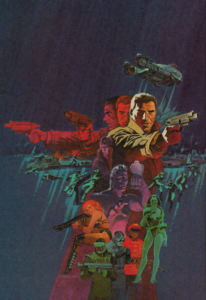Home »

Timely sci-fi classic Blade Runner screening Friday
 BLADE RUNNER: The Future Is Now
BLADE RUNNER: The Future Is Now
By Ferdy Belland
With the release of Stanley Kubrick’s wondrous cinematic imagining of Arthur C. Clarke’s 2001: A Space Odyssey in 1968, moviemakers around the world have worked tirelessly ever since to elevate the needlessly-derided creative genre usually referred to as “Science Fiction” to the big screen, molding dazzling futurescapes into kinetic life in an effort to explain the Human Condition – using futuristic scenarios to explain the present.
One of the most enduring sci-fi movies made over the past half-century has been Ridley Scott’s 1982 classic Blade Runner, which will be shown at the Studio Stage Door Theatre in Downtown Cranbrook this Friday, November 15 as the latest event promoted by The Rep – the cult-film society helmed by the tireless Gordon Sheridan.
Blade Runner is a loose adaptation of maverick sci-fi author Philip K. Dick’s 1968 novel ‘Do Androids Dream of Electric Sheep?’ The movie brought a modern resurgence in international re-appraisal of Dick’s cerebral, quasi-psychedelic works, which also include ‘The Man in the High Castle,’ ‘We Can Remember It For You Wholesale’ (filmed as Total Recall), ‘A Scanner Darkly,’ ‘Minority Report,’ ‘Paycheck,’ ‘Screamers,’ and ‘The Adjustment Bureau,’ among others yet unfilmed.
Ironically, Dick himself died in March 1982 at the age of 53, two months before Blade Runner was released in theatres.
Ridley Scott was fresh from his dark-horse 1979 space-horror triumph of Alien, which set new towering standards for production design and special effects, and as a long-time fan of Dick, was eager to pull out all the movie-making stops. In the wake of the explosive breakout success of the Star Wars saga, Hollywood fell over itself during the late 1970s and early 1980s in an attempt to cash in big-time on a burgeoning global audience hungry for all things involving spaceships, robots, aliens, laser guns, and explosions (quality be damned), and Scott’s film made an immediate startling impact. It continues to do so.
 Set in a gloomy dystopian future of Los Angeles in (ahem) November 2019, Blade Runner tells the story of rough-edged LAPD officer Rick Deckard (played by Harrison Ford in one of his most outstanding roles), whose specialized police duties involve the hunting and killing of renegade servant androids, deemed “Replicants,” who go rogue and turn against their human masters.
Set in a gloomy dystopian future of Los Angeles in (ahem) November 2019, Blade Runner tells the story of rough-edged LAPD officer Rick Deckard (played by Harrison Ford in one of his most outstanding roles), whose specialized police duties involve the hunting and killing of renegade servant androids, deemed “Replicants,” who go rogue and turn against their human masters.
 A group of murderous Replicants led by the cunning Roy Batty (the unforgettable Rutger Hauer, the late great acting hero of the Netherlands) and his simmering love interest Pris (pre-Splash Daryl Hannah) make their way to Earth (off-limits to non-humans) in a determined attempt to contact their creators at the notorious Tyrell Corporation in order to extend their five-year lifespans into normal human longevity. Hilarity ensues.
A group of murderous Replicants led by the cunning Roy Batty (the unforgettable Rutger Hauer, the late great acting hero of the Netherlands) and his simmering love interest Pris (pre-Splash Daryl Hannah) make their way to Earth (off-limits to non-humans) in a determined attempt to contact their creators at the notorious Tyrell Corporation in order to extend their five-year lifespans into normal human longevity. Hilarity ensues.
Actually, that’s a bad joke: there’s nothing humorous at all about Blade Runner.
The perceived future world of November 2019, as dreamed 37 years ago, is still as visually and emotionally captivating as the true present of November 2019. We live in a world where robotics firms are truly building humanoid robots with lifelike appearances and fluid movement; artificial intelligences that can understand and communicate with the humans who built them – military robots (Boston Dynamics aims to contract infantry-soldier units to the US Department of Defense by 2021), pleasure robots (a gynoid brothel opened in Vancouver earlier this year), worker-labour robots (suitable for the global mining industry). And they’re all getting more and more sophisticated and lifelike, day by day.
It is a bleak world of hulking, imposing corporate architecture, where the starless skies are darkened with environmental decay and unending rainfall, and the beautifully mournful synth-drenched soundtrack of Vangelis doesn’t lift the mood at all. The shuffling, ragged citizenry of this Los Angeles is a multicultural mish-mash of faded fashion, fusion cuisine, and hybrid language; the toughened character of Deckard’s LAPD partner Gaff (one of Edward James Olmos’ finest performances) speaks a nigh-incomprehensible dialect of half a dozen European and Asian tongues (not dissimilar to modern hip-hop slang), and despite an Hispanic appearance, leaves intricate Japanese origami figurines as clues – and warnings – for Deckard. Ten-story video billboards advertising Coca-Cola and Pleasuredomes are now a common sight on the Ginza in Tokyo – and Times Square. Perhaps we don’t quite have flying squad cars or off-world colonies as yet, but Ridley Scott’s imagination wasn’t all that off the bullseye, and he hit most of the inner rings of reality.
As is the common case with most technologies predicted by the science-fiction writers of yesteryear, what was once dismissed as unfeasible fantasy is now glowering, unavoidable fact – or will be released to public market within three or four weeks. Brrrrrr…
Blade Runner asks a lot of unsettling questions which ring true in our modern times of smartphone-driven voice-commanded help from Siri and Alexa – and this ties in with the truly frightening threats of the human-hating, apocalypse-mongering killing machines such are found in the ‘Terminator’ movies. What is the definition of Humanity? What is Real? How reliable are our memories? The Tyrell Corporation’s motto is “More Human Than Human.” The Replicants are given memory implants to convince themselves they are not mindless, purposeless automatons, and one of the movie’s supporting characters, Tyrell Corporation executive-assistant Rachel (played with sultry cool by Sean Young), takes nearly half the movie to be convinced by Deckard that she, too, is a Replicant – the cloning techs have done their job that well.
Synthetic flesh doesn’t prevent Deckard from falling in love with the things he’s paid to kill. The Replicants, although dangerous and violent, are portrayed as sympathetic characters being heartlessly persecuted in a cruel world by humans acting inhumanely, and Roy Batty’s legendary “Tears In Rain” soliloquy (pictured above) is one of the most memorable lines of dialog in all 20th-Century cinematic history – sadness and compassion reach parallel heights.
The movie’s dark style, futuristic designs and cutting-edge special effects have all been a striking influence on countless films, TV shows, video games, anime, and works of literature over the past three and a half decades.
Blade Runner was selected for preservation in the US National Film Registry and is frequently voted as one of the all-time best science-fiction movies ever made – or, just one of the best movies ever made, period. It is often described as “Future Noir,” especially with the version (warning: there’s a confusing array of different cuts of Blade Runner) where Rick Deckard’s character provides a cynical, world-weary voice-over monologue, much like a hard-boiled private-detective character from an old pulp story by Mickey Spillane or Dashiell Hammett…another reason why comfortably familiar stagings keep the viewer enthralled in this rather bizarre cop-mystery.
Blade Runner earns its reputation and its legend honestly, especially now that we’re all awakened within its setting of November 2019. And enjoying the work in the public intimacy of a cinematic environment will indeed be a Human Experience – anyone can sit alone in their homes, glued to Netflix, but only 80 of us will get the chance to witness a historic chunk of Entertainment-as-High-Art this coming Friday, November 15 at the Studio Stage Door Theatre.
Will You Be There? Will You Dream of Electric Sheep?
 The Rep presents a one-time screening of Ridley Scott’s 1982 sci-fi masterpiece Blade Runner at the Studio Stage Door Theatre (11 11th Ave S., Cranbrook), Friday November 15 (Doors open 7 p..m, Showtime 7:30 p.m.).
The Rep presents a one-time screening of Ridley Scott’s 1982 sci-fi masterpiece Blade Runner at the Studio Stage Door Theatre (11 11th Ave S., Cranbrook), Friday November 15 (Doors open 7 p..m, Showtime 7:30 p.m.).







